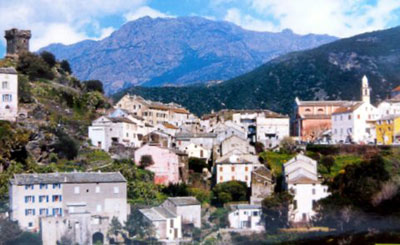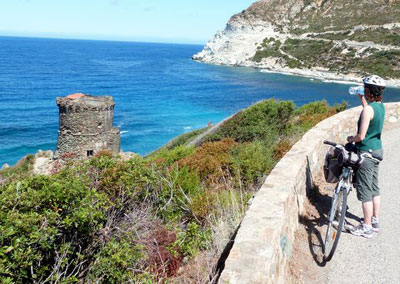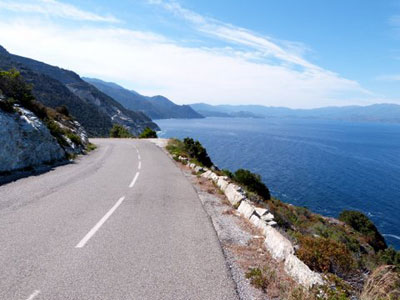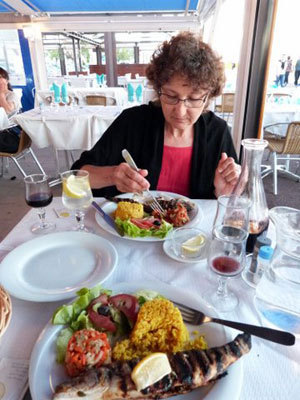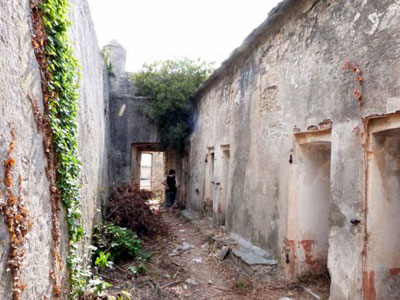Biking along the coast in Corsica
This article appears on page 16 of the January 2014 issue.
by Steve Lopes; Lawrence, KS
My wife, Lois (65), and I (70) are active seniors with a simple travel philosophy: take the most-challenging trips possible while we are able and save the rest for later. Following that philosophy, we’ve hiked the Inca Trail, climbed Mt. Kilimanjaro, gone caving in Belize and entered volcanoes in Nicaragua.
We eschew group travel, preferring to use local guides when necessary. For a trip in June 2013, biking Corsica met our requirements. So how did we decide on this trip?
Finding the right fit
In addition to devouring each issue of ITN, I troll Lonely Planet’s Thorn Tree travel forum as well as other online travel discussions for trip suggestions.
Last spring, Utracks advertised “Corsica Cycle,” an 8-day (in actuality, seven) self-guided tour for $1,460 each plus rental costs for a bicycle, helmet, etc. In researching the trip, we both became intrigued by the beauty Corsica appeared to offer, but I knew my wife was unlikely to survive their prescribed itinerary of 60 to 80 kilometers per day, so I sought a less-challenging route and a more reasonable price.
After some online research, I found a “family friendly” itinerary from British-based Freedom Treks (East Sussex, UK; phone +44 [0] 1273 224066). If I had been more persistent, I would have discovered that Freedom Treks is a pass-through British travel agency that was handling bookings for Europe Active (Borgo, Corsica; phone +33 495 444 967) and I might have saved a few pounds sterling if I had booked with Europe Active directly.
“Around the Cape of Corsica and its Genoese Towers” offered six nights’ accommodation for $895 per person. In addition, we rented two 21-speed hybrid bikes ($117 each) and helmets ($6.50 each) for a total trip cost of $2,037, which seemed reasonable. From June 18 to 24, we bicycled unescorted around Cap Corse, following the 86-mile D80 coast highway of consistently stunning scenery dotted with some of the island’s 60 remaining Genoese towers. (An optional 109-mile route was also detailed.)
Getting there
Getting from the US to our starting point in Bastia, Corsica, wasn’t easy. We had great Kansas City-Philadelphia-Paris and (return) Paris-Philadelphia-Kansas City flights on US Air, and we were pleasantly surprised by their excellent in-flight service. But since our transatlantic flight landed at Charles de Gaulle (CDG) airport and the only nonstop flights to Corsica left from Orly Airport, it was worth the overnight we spent in Paris at Le Regent Hostel (37 boulevard de Rochechouart; leregent.com), located in Montmartre ($40 per person).
We also stayed there on our return, and I was able to watch l’arrivée du Tour de France in Paris.
Flights from CDG to Bastia were expensive and entailed a full day of travel, with flights on multiple airlines and layovers. In contrast, our one-hour Air France nonstop Orly-Bastia flight cost a mere $96 each.
Some history
All I had known previously about Corsica was that Napoleon was born there and that blood feuds and criminal violence were, historically, common. The most recent (2010) Lonely Planet “Corsica” guide gave me pause when I read, “In the 18 months preceding our research on the island, there were 22 clan slayings, mostly a settling of scores in broad daylight…. Not one has resulted in prosecution, principally because witnesses are unwilling or too scared to talk. By contrast, in 2008 the number of bombings…was at its lowest since 1973. However, at 89 blasts, it is still a figure that would make most of the world shudder.”
Nevertheless, violence against visitors is virtually unknown, and the safety of travelers is understood to be vital in protecting this important source of income for the island’s inhabitants.
Further reading helped me understand that Corsica was a part of Genoa for five centuries before being purchased by the French in the 18th century. This Italian-French tension is obvious on the bilingual signage that has either the French or Italian destination spray-painted over or shot up in defiance.
There are also Corsicans who would prefer independence and seek acceptance of their unique language.
Nevertheless, we felt we were treated with the utmost kindness and generosity by every Corsican we met.
Beginning in Bastia
After arriving in Corsica, we took the 20-minute airport bus ride to the tourist office in downtown Bastia (€9.50, or $12.80, each). Hôtel Bonaparte, our accommodation for our first and last nights, was located behind it.
Hôtel Bonaparte was a clean, 2-star property with a great location and a staff with limited English skills.
Bastia (derived from the Italian word for “citadel”) has a quaint charm that is worn down by the many cruise ship visitors. On our first day, I enjoyed Lonely Planet’s 1½-hour self-guided walking tour from the tourist office to Vieux Port (Old Port) and the charmingly dilapidated Citadel.
There were many excellent restaurants around place Saint-Nicolas serving fresh seafood that was a delightful fusion of French and Italian cuisines. We had neither a bad meal nor less-than-tasty wine anywhere on Corsica.
After a fair night’s sleep (our hotel was over a fashionably noisy bar), we had our first and only contact with the Europe Active representative at precisely 9 a.m. outside our hotel. He had come to make sure we understood the rules of the road. Because we had booked the trip through a British company, he wanted us to be certain to ride on the right side of the road. After we told him we were from the US, he relaxed.
He took our luggage and told us that we were to leave our bags with reception at each hotel before 9 a.m. and Europe Active would transfer them to our next evening’s accommodation. Sometimes they would be transferred by mail, sometimes by taxi and at other times by a company representative. Our bags were waiting for us each evening at our destination. On the last day, we just left the bikes in a closet at Hôtel Bonaparte.
I couldn’t determine the brand or even the country of origin of the 21-speed hybrid bikes, but they were first-rate, with comfortable seats and sturdy frames. Each was equipped with panniers, canvas bags over the rear wheel that accommodated our picnic lunches, cameras and three 1.5-liter bottles of water. A sturdy combination lock, tool kit, spare tube and hand pump on each bike completed our outfit.
Europe Active also gave us a telephone number to call if we had any problems, but we had no trouble, not even a flat tire, during the entire week. Their maps provided optional routes with graphs showing the rate of the climb per kilometer.
We were on our own for five days in a foreign land where few spoke English. Although my traveler’s French worked well enough, those with limited language skills might consider taking a pocket translator.
The route
Cap Corse is a 6-mile-wide thumb that juts northward for 25 miles with a highway that hugs stunning coastline for 80-plus miles. The smooth, 2-lane D80 is incapable of offering a less-than-spectacular view of the ocean or charming villages from any point. But “two lanes” meant no bike lane, so we had to share the road with cars, motorcycles and (yikes!) tour buses.
Fortunately, Corsican drivers respect bikers, and we never felt threatened by recklessness. Also, the road surface was mostly smooth, so we could enjoy the view without fearing potholes.
Our itinerary consisted of two relatively easy days, two difficult days and one Goldilocks day. The weather was perfect, with sunshine and moderately warm temperatures that required only adequate drinking water and SPF 30 sunscreen.
After stocking our picnic lunch at a supermarché, we left Bastia for an easy 10-mile ride north along D80 to a spot where we could walk down to the shore and enjoy lunch. Hôtel U Pozzu at Marine de Sisco, located at the intersection of D80 and D32, was comfortable, and our fresh seafood dinner at the hotel (€52, or $70, for two, including a liter of house wine) was very good.
On our third day, we bought our typical picnic lunch from Utile Sisco — a bottle of local wine plus water, bell peppers, fruit, a baguette and cheese for €17 and followed the coastline for 15 miles to Hôtel U Libecciu (www.u-libecciu.com), a 3-star hotel in Macinaggio, which we shared with bus-tour groups.
That afternoon I hiked the Sentier des Douaniers (Customs Officers’ Route), passing the Santa Maria Tower; it was worth the walk. Dinner at Restaurant Les Iles was two fish entrées, crème brûlée and a half liter of wine for €58.
The next day featured a very difficult 37-mile ride as we climbed up 320 meters (1,100 feet) to Au Bon Clocher (aubonclocher.fr) at Canari. Lois was not happy to have to walk her bike the last five kilometers.
A delicious dinner at the hotel (€55) offered some compensation.
We enjoyed the great sunset view, but we both were exhausted from the intense climb.
The next day we welcomed a mostly downhill ride on the way to Hôtel Maxime in Saint-Florent, clearly a yacht mecca for the rich and famous.
We toured the waterfront and the unrestored Citadel before having dinner at La Maison des Pizza (place du Monument), where we had a chef’s salad, two salmon entrées, fresh pineapple and 750cl of wine for €75.
Along the way, we enjoyed a visit to Nonza, the most picturesque village along the Corsican coast.
On day six we biked 2½ hours and 17 miles from Saint-Florent to Bastia over the mountain spine of Cap Corse before coasting down to Bastia. The climb from sea level to the pass at Teghime (1,700 feet) was worth the work for the view of the Gulf of Saint-Florent on the west and the beach at Manara on the east. The entire route, though challenging, was beautiful and rewarding.
Back in Bastia, we enjoyed a prix fixe dinner for €18 per person plus €10 for house wine.
After our last night at Hôtel Bonaparte, we were off to Morocco for a week of trekking among Berbers in the High Atlas.
The hotel staff ordered a taxi for us, since the airport bus was available only to meet the few arrivals each day and did not schedule transportation for departures.
What’s the take-away from our experience? As active seniors, we can only encourage everyone to seize the day. If we can do it, you can as well! There is no better way to get close to nature than on a bicycle.

